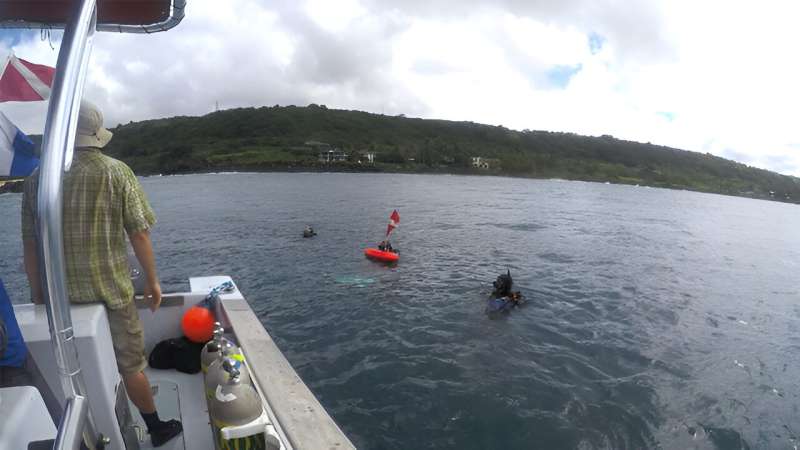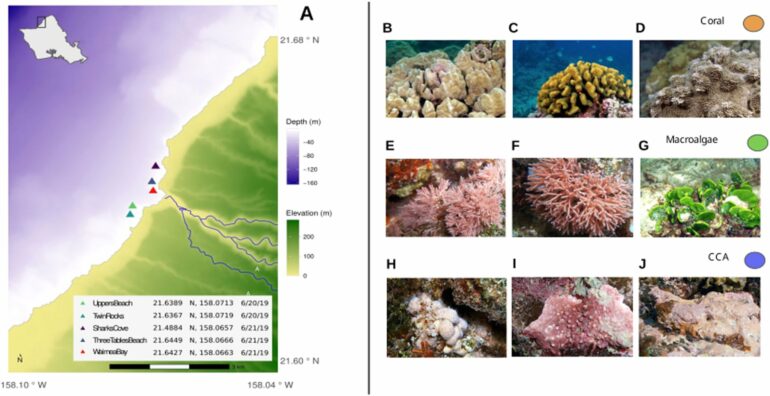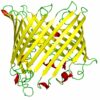Researchers may have a new way to monitor the health of reefs around HawaiÊ»i. A study co-led by a University of HawaiÊ»i at MÄnoa doctoral student has revealed that each type of coral and algae from a coral reef produced a unique suite of chemical compounds. Many of these new metabolites haven’t been studied before. They could provide important insight into how healthy the reef organisms are.
The study is published in the journal Communications Biology.
In a coral reef ecosystem, macroalgae, also called limu, coral and crustose coralline algae (a hard, rocky covering that grows on coral reefs that helps keep the reef strong and provides homes for other creatures) are the primary producers that act as the underwater equivalent of plants in a forest. These groups fuel the ecosystem by converting sunlight into energy, and play a variety of other roles in the environment through the microorganisms they harbor and the different chemical compounds they produce.
“Together, microorganisms and organic chemicals in the ecosystem can tell us about coral reef health,” said Sean Swift, co-lead author of the study and marine biology doctoral candidate in the UH MÄnoa School of Ocean and Earth Science and Technology (SOEST). “This provides a window into how primary producers react to disease or environmental stress, and how these organisms maintain a healthy microbiome in dynamic coral reef systems.”
Assessing microbial diversity
As part of a broad microbial research effort in the watershed of Waimea Bay on OÊ»ahu, organized through the UH MÄnoa Center for Microbiome Analysis through Island Knowledge and Investigation, Swift and a team of scientific divers, including undergraduate and graduate students, collected more than 100 samples of coral reef organisms from five sites around Waimea Bay.
The researchers extracted microbial DNA from the samples and identified more than 36,000 unique microbial groups associated with larger host organisms. Limu tended to harbor microbes that are equipped to break down large organic molecules, like the complex carbohydrates that are typically exuded by limu. Coral and crustose coralline algae were found to harbor microorganisms associated with the recycling of inorganic nutrients, such as nitrogen, which may be a clue as to how corals persist in nutrient poor waters.

Researchers diving in Waimea Bay. © Sean Swift
Using technique to monitor Lahaina waters
Some of the UH MÄnoa researchers involved in this project are now assessing the aftermath of the Maui wildfires by studying the effects that urban fire runoff may be having on nearby coral reef ecosystems.
“We will use these techniques to assess reef health and identify fire-derived contaminants in environmental samples, like water and sediment, and in the tissues of reef organisms such as corals, algae, and fish,” said Craig Nelson, lead investigator on the study and professor with the Center for Microbial Oceanography: Research and Education and HawaiÊ»i Sea Grant in SOEST. “Our main focus is to use these techniques to understand how fire-related contaminants entering the waters around Lahaina may be affecting reef health.”
Organic compounds provide additional health info
In collaboration with the Dorrestein Lab at the University of California (UC), San Diego, the team analyzed the samples using high-throughput organic chemistry techniques that are known as “untargeted metabolomics” and identified more than 10,000 distinct chemical features.
“Each compound might be a food source for microbes, or a signaling compound used for communication, or a defense compound that deters competitors,” said Helena Mannochio-Russo, co-lead author and postdoctoral researcher at UC San Diego.
“These unique compounds likely represent undiscovered chemical diversity,” said Nelson. “These coralline algae are well known for inducing settlement in larval corals and other organisms, and our previous work has similarly demonstrated that they also release many novel compounds into the water. Unraveling the mystery of these chemical cues is the next frontier in marine ecology.”
More information:
Helena Mannochio-Russo et al, Microbiomes and metabolomes of dominant coral reef primary producers illustrate a potential role for immunolipids in marine symbioses, Communications Biology (2023). DOI: 10.1038/s42003-023-05230-1
Provided by
University of Hawaii at Manoa
Citation:
A catalog of coral microbes and metabolites paves the way to monitoring reef health (2024, March 11)



